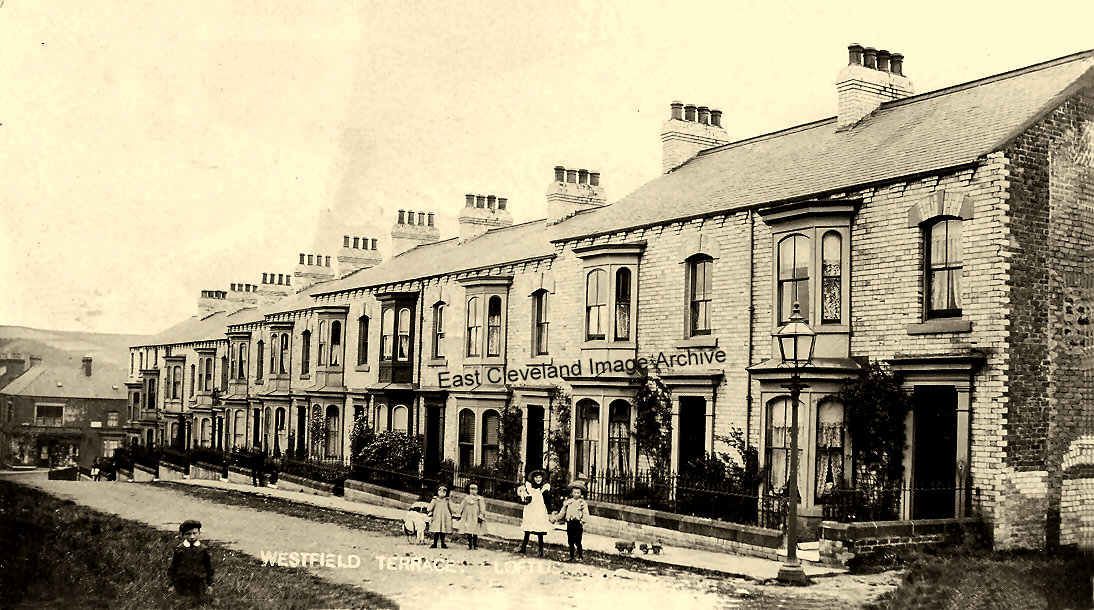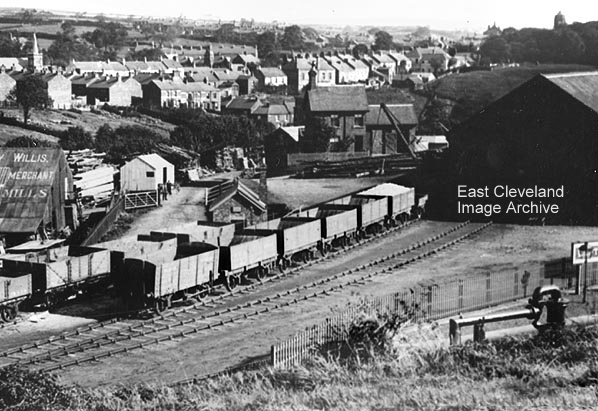
A good image of these upper class terraced houses (fancy facing bricks) with the usual inquisitive urchins posing for the photographer.
|
|
||
|
A good image of these upper class terraced houses (fancy facing bricks) with the usual inquisitive urchins posing for the photographer.
A young gentleman poses for the camera on Westfield Terrace, could it be before 1940 as the iron railings are still there? As the older ones amongst us know the iron railings were all taken during the war. Image courtesy of Jean Dean.
A view down the length of Westfield Terrace, from the junction with Coronation Road to the Congregational Church on the corner of West Road. The two large houses at the top were built later that the rest of the terrace. Image courtesy of Mrs Sakelaropoulos.
This photograph gives us a new perspective on Loftus; this view looks over the field behind the Leisure Centre and the houses of Rosedale Crescent to Hummersea Hills, formerly Westfield Estate; nick name “Colditz” being applied owing to its resemblance to the WWII prison with that name. Hummersea School can be seen to the front left of the estate. It took a while to get our heads round this view; the terraced streets of East Loftus can be seen behind the estate, on the right of the picture and Easington is in the background, on the left. Image courtesy of Julie Riddiough; thanks to Maurice Dower and Margaret Atkinson for the updates.
This photograph is a continuation of the previous one; looking down on the middle of Loftus from the top of Brotton. The roof of the Leisure Centre is on the left, beside the rooftops of the Mars estate. We can see along Coronation Road to the bright roofs of South View and the buildings in the Market Place. The towers of the Town Hall and St Leonard’s Church can be made out on the right. The Arlington estate can be seen beyond the Market Place and the terraced streets of East Loftus are on the left of the photo. The fields in the background go up to the skyline at Roxby. Image courtesy of Julie Riddiough.
A George Skilbeck postcard view of Coronation Road taken from the east these are the private houses, we were unsure if it was a clear enough picture to see if the council houses were there when it was taken. Norman Patton tells us: ”The picture would be taken around the early 1950s. The VHF television aerials started to be common place about that time, events such as the Coronation and Stanley Matthew’s Cup winner’s medal with Blackpool shown from Wembley! the “council houses” were built quite a while before this, perhaps even late 30s.” Margaret Atkinson tells us: ”My gran and mam were first tenants to move they lived at no 11 that was 1939 their name was Meggie Trevor.” The 1939 Census (taken at the outbreak of the Second World War) tells us that Meggie and her son Arthur were resident at 11 Coronation Road. Image courtesy of Ken Johnson and many thanks to Norman Patton and Margaret Atkinson for the updates.
Here is another first, we had previously no other photographs of the foundry at Loftus. Do you have any to loan us please? Eric Johnson comments: ”An interesting view of the cupola melting furnace at the foundry, apparently being demolished. Three men are on the charging platform, the charging door on the cupola is open where the charge of pig iron/coke/limestone was introduced. To the right is a hoist on a large beam (above the standing men), used to raise the charges to the platform. At the base of the cupola the air chest for the blast around the cupola can be seen, with air pipe disconnected. Standing on 4 legs, the cupola probably had a drop bottom for emptying slag etc after the days run. The foundry originally owned by Robinson Brothers who produced farm implements, ploughs, etc. They also cast drain covers and gulleys, many of which can still be seen on the streets of East Cleveland. I have seen one at Piercebridge, Co. Durham. A speciality (unique?) were the cast iron gravestones, seen in the old cemetery. Robinson Bros were regular exhibitors at the Wool Fairs in the Market Place, Loftus. Old images show many of their products and warehouse next to the present day Post Office. I believe the foundry was taken over by Tinsley & Co. and is now used by Steve Whitlock.” Bill Tinsley tells us: ”Zetland foundry was owned by my grandfather until his death in the late 1930s. My father was a mining engineer with Richard Sutcliff in Horbury near Wakefield who sold a half-share to a manager who continued to run the foundry until around 1950. I spent a lot of time there as a child with my grandfather watching and getting in the way but even as a 7 or 8 year old I learned quite a lot about casting and machining methods There was a small machine shop at the far end of the buildings.” Bill also tells us: ”The cast iron railings round Saltburn Bandstand were made by grandfather at Zetland Foundry in the mid thirties but unfortunately removed early in Second World War and melted down for the war effort. Incidentally Thomas Tinsley was apprenticed to John Wood and Co (Steam engine and winch manufacturers in Lancashire) in July 1881.The papers which I still have includes phrases “Shall not wast the goods of his masters,Shall not frequent taverns or playhouses,or contract matrimony”.The apprentiship was for “Engine Fitting”. He later went on to be chief engineer at Nostel mine nr. Wakefield before buying Zetland Foundry. I have 3 photographs taken in 1970 when I last went there,one showing a similar view with the cupula removed, but just possible to see part of the words Zetland Foundry on the hoist beam. Another showing the brass name plate (Thos Tinsley & Son) on the old office door and the third showing his house in Saltburn.” Photograph courtesy of Keith Bowers and thanks to Eric and Bill Tinsley for the updates.  Another from a series of photographs taken from the same vantage point. This image looks across the goods yard towards Loftus.
One of a series of photographs taken from Loftus Station, looking over the Station Yard. This one taken in winter from the bankside above the railway station, which can be seen bottom right with the goods yard behind it. Still in the era of horse-drawn transport and unbraked rolling stock, so probably taken around 1900. For once the signage on the roof of the Carnaby Willis wood yard fails to promote the business!
This postcard view of Loftus from the railway station was taken in 1906 (7th July to be precise); it was one of a range produced by John Thomas Ross (a noted Whitby photographer). Image courtesy of Ruth Wilcock. |
||
Recent Comments